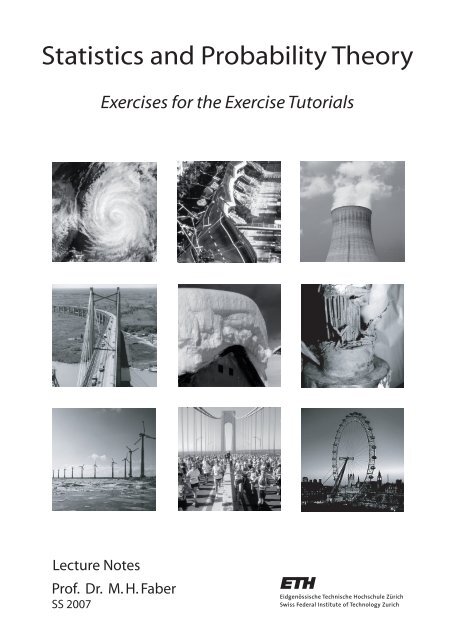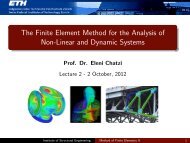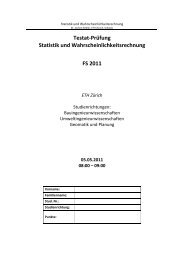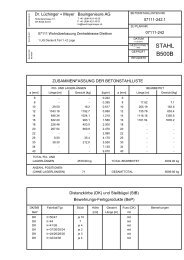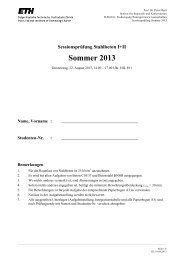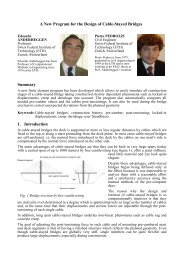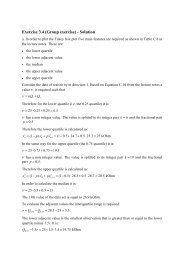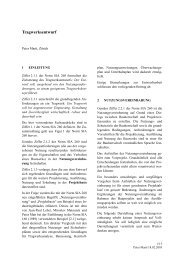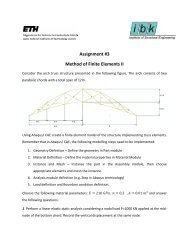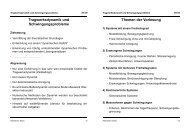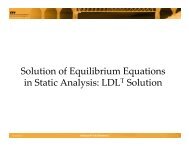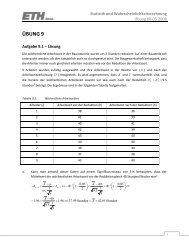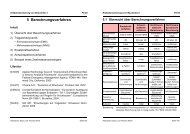Statistics and Probability Theory
Statistics and Probability Theory
Statistics and Probability Theory
You also want an ePaper? Increase the reach of your titles
YUMPU automatically turns print PDFs into web optimized ePapers that Google loves.
<strong>Statistics</strong> <strong>and</strong> <strong>Probability</strong> <strong>Theory</strong><br />
Exercises for the Exercise Tutorials<br />
Lecture Notes<br />
Prof. Dr. M. H. Faber<br />
SS 2007
Copyright © 2007 Michael H. Faber
EXERCISE TUTORIAL 1<br />
Exercise 1.1<br />
In spite of a small seismic activity, the risk of a large earthquake with significant<br />
consequences always exists. A large earthquake may occur once in 1000 years. In a given<br />
region, 300 years have passed without a significant earthquake occurring. How large is the<br />
probability that a significant earthquake will occur in this region, in the current year?<br />
The probability has increased<br />
The probability has remained the same<br />
The probability has decreased<br />
□<br />
□<br />
□<br />
Exercise 1.2<br />
Considering an activity with only one event with potential consequences, the risk is that<br />
probability that this event will occur multiplied with the consequences given the event occurs-<br />
Which of the following events is associated with the highest risk?<br />
Event 1 2 3<br />
Event probability 10% 1% 20%<br />
Consequences 100 SFr 500 SFr 100 SFr<br />
Risk<br />
Exercise 1.3<br />
Following a number of different activities is given, which involve death as a possible<br />
consequence. Which is the riskiest one?<br />
Crossing a bridge<br />
Smoking 20 cigarettes per day<br />
Traveling 100000 km by train<br />
□<br />
□<br />
□<br />
Exercise 1.4<br />
In a region, an investigation was carried out of the number of storks <strong>and</strong> births. It was figured<br />
out that when the number of storks is high then the amount of births is also high <strong>and</strong> vice<br />
versa. The statistics indicate that these events – the number of births <strong>and</strong> the number of storks<br />
are correlated. What do you think?<br />
1.1
It has been proved statistically that the storks bring the children<br />
There is no direct connection between the two events so we cannot speak about<br />
correlation<br />
The statistical analysis has shown that the stork is a protected bird<br />
□<br />
□<br />
□<br />
Exercise 1.5<br />
A reinforced concrete bridge shows large cracks at mid span. As a result water can reach the<br />
reinforcement <strong>and</strong> eventually corrosion will initiate. What is more probable?<br />
A failure of the bridge at mid span under the action of an abnormal load<br />
A failure of the bridge under the action of an abnormal load<br />
□<br />
□<br />
Exercise 1.6<br />
Engineer Meier is “1000%” certain that the pedestrian bridge constructed by him is capable to<br />
withst<strong>and</strong> the load resulting from the bike racers taking part in the “Tour de Suisse”. Which<br />
statement is correct?<br />
Mr. Meier has made a wrong evaluation. A “200%” certainty would be enough<br />
If Mr. Meier made no miscalculations, he is right<br />
There is neither 1000% certainty nor absolute safety in civil engineering<br />
□<br />
□<br />
□<br />
Exercise 1.7<br />
In an Alp region, there are 25 very high summits. These are covered with snow over the entire<br />
year <strong>and</strong> each day there is the same probability of occurrence of an avalanche. This amounts<br />
to 1/40. How large is the probability in this region of at least two avalanches occurring at the<br />
same day? It is assumed that only one avalanche may occur on the same summit at the same<br />
day.<br />
Exercise 1.8<br />
A non destructive test method is carried out to determine whether the reinforcement of a<br />
structural component is corroded or not. From a number of past tests, it is known that the<br />
probability of the reinforcement being corroded is 1%. If the reinforcement is corroded, this<br />
will be indicated by the test. However there is also a 10% probability that the test will indicate<br />
that the reinforcement is corroded although this is not true (false indication).<br />
How large is the probability that corrosion is present, if the non destructive test indicates<br />
corrosion?<br />
1.2
EXERCISE TUTORIAL 2<br />
Exercise 2.1<br />
a. Which of the following expressions are meaningful in the way they are written?<br />
i) P ⎡⎣A∪[ B∩C]<br />
⎤⎦ ii) P[ A]<br />
+ P[ B]<br />
iii) P ⎡<br />
⎣A⎤∩<br />
⎦ P[ B]<br />
iv) P[ B ]<br />
b. Assume A, B <strong>and</strong> C represent different events. Explain in words the meaning of the<br />
following expressions <strong>and</strong> what they represent in mathematical terms (i.e. numbers,<br />
vectors, functions, sets).<br />
i) A∪ B ii) B ∩ C iii) P[ A ]<br />
iv) ⎡[ ]<br />
P A∩B∩C ∪⎡A∩B∩C⎤⎤<br />
⎣<br />
⎣ ⎦⎦<br />
v) ∅<br />
c. Using the diagram provided below show the following events.<br />
i) C D<br />
∩ ii) [ D\C] [ C A]<br />
∪ ∩ iii) B ∪ D<br />
Ω<br />
D<br />
C<br />
A<br />
B<br />
Exercise 2.2:<br />
We are throwing an ideal dice <strong>and</strong> considering the following events:<br />
Case 1). A: “An even number comes“<br />
B: “A number dividable by 3 comes“<br />
Case 2) A: “An even number comes”<br />
B: “A prime number comes”<br />
For each case, calculate the probability that both events (A <strong>and</strong> B) occur simultaneously.<br />
2.1
Exercise 2.3:<br />
The observation of the traffic flow at a crossing, see the following figure, shows that n 1 = 50<br />
vehicles move on the main road in direction 1. From those m 1 = 25 vehicles turn to the<br />
secondary road. n 2 = 200 vehicles move on the main load in direction 2 <strong>and</strong> m 2 = 40 vehicles<br />
turn to the secondary road. How large is the probability that a vehicle moving on the main<br />
road will turn to the secondary road?<br />
Secondary road<br />
m 1 +m 2<br />
n 1<br />
Main road<br />
n 2<br />
Exercise 2.4:<br />
Measurements are to be carried out with measurement devices. Since a large number of<br />
devices is required, 20% of them will be provided by IAC (Institute for the Atmosphere <strong>and</strong><br />
Climate) <strong>and</strong> 80% will be provided by IHW (Institute for Hydraulics <strong>and</strong> Water<br />
management). 5% of the devices provided by IAC do not fulfill the required accuracy, while<br />
2% of the devices provided by IHW do not fulfill the required accuracy.<br />
A student carried out a measurement using a device without knowing from which institute the<br />
device was provided. Thereby, she found the inaccuracy involved in the measurement. How<br />
large is the probability that the measurement was carried out with a device provided by IAC?<br />
Exercise 2.5:<br />
In exercise tutorial 1, exercise 1.8 was given as:<br />
A non destructive test method is carried out to determine whether the reinforcement of a<br />
structural component is corroded or not. From a number of past tests, it is known that the<br />
probability of the reinforcement being corroded is 1%. If the reinforcement is corroded, this<br />
will be indicated by the test. However there is also a 10% probability that the test will indicate<br />
that the reinforcement is corroded although this is not true (false indication).<br />
How large is the probability that corrosion is present, if the non destructive test indicates<br />
corrosion? Calculate the probability using the Bayes’ theorem.<br />
2.2
Exercise 2.6:<br />
The failure of a building in the city of Tokyo may be caused by two independent events:<br />
F<br />
1<br />
:<br />
F<br />
2<br />
:<br />
A big earthquake.<br />
A strong typhoon.<br />
The annual probabilities of occurrence of the above events are:<br />
PF (<br />
1) = 0.04<br />
PF (<br />
2) = 0.08<br />
Calculate the annual failure probability for the building.<br />
Exercise 2.7 (Group Exercise):<br />
Due to the increasing dem<strong>and</strong> on drinking <strong>and</strong> processing water, the groundwater discharge<br />
flow has to be discussed. The hazard of long-term ground-lowering is analysed, whereby it is<br />
assumed that the ground-lowering depends on the thickness of the clay layer, h . The<br />
thickness of the clay layer is classified in the following:<br />
C 0≤h≤<br />
20cm,<br />
C : 2<br />
20cm < h ≤ 40cm<br />
, C : 40cm < h<br />
3<br />
1 :<br />
Based on experience a geologist estimates the following prior probabilities that the thickness<br />
of the clay layer at a site belongs to one of the above cases:<br />
PC (<br />
1) = 0.2, PC (<br />
2) = 0.47 , <strong>and</strong> PC (<br />
3) = 0.33<br />
A geo-electrical test may be useful to update the prior probability on the ground category,<br />
although the test result may not always be correct. From past experience, the probabilities of<br />
the correct/false indication of the test are known as are listed in the (uncompleted) table<br />
below:<br />
Category of thickness<br />
of clay layer C<br />
i<br />
Indication of the category of the thickness of the clay layer<br />
I C 1<br />
I<br />
C<br />
= =<br />
2<br />
=<br />
3<br />
I<br />
C<br />
C<br />
1<br />
0.84 0.03<br />
C<br />
2<br />
0 0.77<br />
C<br />
3<br />
0.02 0.89<br />
Table 2.7.1:<br />
a. Complete the table.<br />
<strong>Probability</strong> of indication of the category of the thickness of the clay layer.<br />
b. A geo-electrical test was carried out <strong>and</strong> indicated as C<br />
3<br />
the thickness of the clay layer.<br />
What is the probability that the thickness of the clay layer belongs to C<br />
1<br />
, C<br />
2<br />
, C<br />
3<br />
?<br />
2.3
EXERCISE TUTORIAL 3<br />
Exercise 3.1<br />
Two sets of data are provided, each of which represents the daily traffic flow in<br />
Rosengartenstrasse in Zurich during the month of April 2001 (Table 3.1.1). Direction 1<br />
corresponds to driving towards Bucheggplatz, while direction 2 corresponds to driving<br />
towards Escher Wyss Platz.<br />
Date<br />
01.04.2001<br />
02.04.2001<br />
03.04.2001<br />
04.04.2001<br />
05.04.2001<br />
06.04.2001<br />
07.04.2001<br />
08.04.2001<br />
09.04.2001<br />
10.04.2001<br />
11.04.2001<br />
12.04.2001<br />
13.04.2001<br />
14.04.2001<br />
15.04.2001<br />
16.04.2001<br />
17.04.2001<br />
18.04.2001<br />
19.04.2001<br />
20.04.2001<br />
21.04.2001<br />
22.04.2001<br />
23.04.2001<br />
24.04.2001<br />
25.04.2001<br />
26.04.2001<br />
27.04.2001<br />
28.04.2001<br />
29.04.2001<br />
30.04.2001<br />
Direction 1 Direction 2<br />
unordered ordered unordered ordered<br />
32618<br />
24846<br />
24609<br />
17805<br />
33380<br />
24862<br />
29965<br />
18123<br />
34007<br />
25365<br />
30629<br />
19735<br />
33888<br />
28252<br />
30263<br />
20903<br />
35237<br />
29224<br />
31405<br />
21145<br />
35843<br />
29976<br />
31994<br />
22762<br />
33197<br />
30035<br />
26846<br />
22828<br />
30035<br />
30613<br />
22762<br />
23141<br />
32158<br />
32158<br />
30366<br />
24609<br />
33406<br />
32472<br />
29994<br />
26525<br />
34576<br />
32618<br />
30958<br />
26846<br />
34013<br />
32962<br />
30680<br />
27746<br />
24846<br />
33091<br />
19735<br />
28117<br />
28252<br />
33197<br />
21145<br />
28858<br />
25365<br />
33198<br />
17805<br />
28877<br />
24862<br />
33245<br />
18123<br />
29080<br />
32472<br />
33380<br />
28117<br />
29586<br />
33245<br />
33406<br />
28858<br />
29965<br />
33788<br />
33788<br />
29080<br />
29994<br />
34076<br />
33888<br />
30313<br />
30263<br />
29976<br />
33937<br />
23141<br />
30313<br />
29224<br />
34007<br />
20903<br />
30366<br />
32962<br />
34013<br />
27746<br />
30629<br />
33937<br />
34076<br />
29586<br />
30680<br />
33198<br />
34425<br />
30788<br />
30788<br />
34455<br />
34455<br />
31074<br />
30958<br />
35852<br />
34576<br />
32384<br />
31074<br />
33091<br />
35237<br />
26525<br />
31405<br />
30613<br />
35843<br />
22828<br />
31994<br />
34425<br />
35852<br />
28877<br />
32384<br />
Table 3.1.1: Daily traffic flow through Rosengartenstrasse, Zurich-April 2001.<br />
3.1
Provide frequency distributions <strong>and</strong> cumulative frequency distributions of the observed data.<br />
What is your first impression of the data? Try to make a comparison between the two<br />
directions.<br />
60<br />
55<br />
Direction 1<br />
Fraction of observations, %<br />
50<br />
45<br />
40<br />
35<br />
30<br />
25<br />
20<br />
15<br />
10<br />
5<br />
0<br />
24.5-26.5<br />
26.5-28.5<br />
28.5-30.5<br />
30.5-32.5<br />
32.5-34.5<br />
34.5-36.5<br />
Number of cars (*10 2 )<br />
3.2
40<br />
Direction 2<br />
Fraction of observations, %<br />
35<br />
30<br />
25<br />
20<br />
15<br />
10<br />
5<br />
0<br />
17.5-20.0<br />
20.0-22.5<br />
22.5-25.0<br />
25.0-27.5<br />
27.5-30.0<br />
30.0-32.5<br />
Number of cars (*10 2 )<br />
3.3
Exercise 3.2<br />
Use a Tukey box plot to provide a summary of the main features of the distribution of each<br />
data set of Table 3.1.1. Plot the Tukey box plots on the same graph so that you are able to<br />
compare these features. Do you observe any symmetry in the data sets?<br />
3.4
Exercise 3.3<br />
Make a Q-Q plot (Quantile-Quantile plot) to compare the two data sets of Table 3.1.1. What<br />
do you observe in regard to the traffic flows in directions 1 <strong>and</strong> 2? Provide an approximate<br />
value of the difference in the daily traffic flow between the two directions using a Tukey<br />
mean-difference plot.<br />
35000<br />
33000<br />
Number of cars in direction 1<br />
31000<br />
29000<br />
27000<br />
25000<br />
23000<br />
21000<br />
19000<br />
17000<br />
17000 19000 21000 23000 25000 27000 29000 31000 33000 35000<br />
Number of cars in direction 2<br />
8000<br />
7000<br />
6000<br />
Difference<br />
5000<br />
4000<br />
3000<br />
2000<br />
20000 22000 24000 26000 28000 30000 32000 34000<br />
Mean<br />
3.5
Exercise 3.4 (Group exercise)<br />
Resistivity measurements help to predict the possible corrosion of bridge structures. During a<br />
general bridge inspection the data shown in Table 3.2 were obtained from resistivity<br />
measurements along the two bridge lanes (direction 1 <strong>and</strong> 2):<br />
a. Draw two box plots for the data provided in Table 3.4.1 (direction 1 <strong>and</strong> direction 2).<br />
Show the main features of the box plots <strong>and</strong> write their values next to the<br />
corresponding points on the diagrams. Plot also the outside values, if any.<br />
b. Tukey box plot is a helpful tool for assessing the symmetry of data sets. Discuss the<br />
symmetry/skewness of the resistivity data for both lanes.<br />
c. Choose a suitable number of intervals <strong>and</strong> plot the histogram for the resistivity data of<br />
direction 1.<br />
Measurement Direction 1 Direction 2<br />
No. (i) Resistivity (kOhm) Resistivity (kOhm)<br />
1 20.2 3.8<br />
2 20.4 5.6<br />
3 22.1 6.5<br />
4 23.8 7.1<br />
5 24.3 7.9<br />
6 24.7 8.2<br />
7 25.3 9.1<br />
8 25.6 9.3<br />
9 25.7 9.6<br />
10 25.9 9.8<br />
11 26.2 10.3<br />
12 26.7 10.9<br />
13 26.9 11.1<br />
14 27.3 11.7<br />
15 27.6 12.2<br />
16 27.6 12.6<br />
17 27.8 12.9<br />
18 27.9 13.8<br />
19 28.3 13.9<br />
20 28.7 14.5<br />
21 28.9 15<br />
22 28.9 15.4<br />
23 29.3 17.1<br />
24 29.4 17.8<br />
25 29.9 23.4<br />
Table 3.4.1<br />
Resistivity measurements.<br />
3.6
Exercise 3.5<br />
The data sets in Table 3.5.1 show the number of newcomers to the university <strong>and</strong> the number<br />
of total students at the university. Estimate the correlation of these numbers using the<br />
following calculation sheet.<br />
Univ. A Univ. B Univ. C Univ. D Univ. E Univ. F<br />
Newcomer 3970 732 499 1300 3463 2643<br />
Total students 24273 5883 2847 5358 23442 17076<br />
Table 3.5.1:<br />
Number of newcomers to the university <strong>and</strong> number of total students at the university.<br />
Calculation sheet<br />
x<br />
i<br />
y<br />
i<br />
A 3970 24273<br />
B 732 5883<br />
C 499 2847<br />
D 1300 5358<br />
E 3463 23442<br />
F 2643 17076<br />
xi<br />
− x yi<br />
Σ - -<br />
Σ / n<br />
- -<br />
− y<br />
(x − x)<br />
i<br />
2<br />
(y y)<br />
2<br />
i<br />
−<br />
i i<br />
(x −x)(y − y)<br />
Σ / n - - - - -<br />
Exercise 3.6:<br />
Table 3.6.1 shows observations taken at weather stations located at different heights. Plot the<br />
relations between the temperatures (T max <strong>and</strong> T min ) <strong>and</strong> the heights of the weather stations in<br />
order to see the correlation between the temperatures <strong>and</strong> the heights. Then, calculate the<br />
correlation coefficient of the observed data – Height-T max <strong>and</strong> Height-T min .<br />
Table 3.6.1:<br />
Maximum <strong>and</strong> minimum temperatures observed at weather stations located at different<br />
heights through Switzerl<strong>and</strong>.<br />
3.7
Exercise 3.7:<br />
An experiment was carried out to measure the tensile strength of wood. The critical strength is<br />
assumed equal to the load at which the wood sample broke. In Table 3.7.1 the measured<br />
strengths have been classified in intervals of 5 N/mm 2 . The wood which is assumed to follow<br />
the same distribution as the tested wood is used for the construction of a building. The<br />
probability of failure or the reliability of the wood material can be estimated based on the<br />
measurement results. First draw the histogram <strong>and</strong> the cumulative frequency <strong>and</strong>:<br />
a. Estimate the probability that the tensile strength of wood lies between 20-25<br />
N/mm 2 .<br />
b. Estimate the probability of failure of the wood in the case where 25 N/mm 2 is loaded<br />
to the wood.<br />
Table 3.7.1:<br />
Classified measured wood tensile strengths.<br />
Exercise 3.8:<br />
Identify <strong>and</strong> write down the skewness features (right-skewed or left-skewed) of the<br />
distributions shown in the following figure. Then, mark the median, the mean <strong>and</strong> the mode<br />
for each distribution.<br />
B eDistribution B b Distribution<br />
f X<br />
(x)<br />
f X<br />
(x)<br />
x<br />
x<br />
3.8
EXERCISE TUTORIAL 4<br />
Exercise 4.1:<br />
The monthly expense X [CHF] for water consumption including sewage fee for a 2-persons<br />
household may be considered as a r<strong>and</strong>om variable with the following density function:<br />
⎧c⋅x⋅(60 −x) for 0 ≤ x ≤60<br />
fX<br />
( x)<br />
= ⎨<br />
⎩ 0 otherwise<br />
a. Which value of c should be chosen?<br />
b. Describe the distribution function FX<br />
( x ) of the r<strong>and</strong>om variable X .<br />
c. Which of the following four values, 30.00 CHF, 40.00 CHF, 48.30 CHF <strong>and</strong> 70.40 CHF<br />
does not exceed the 90%-quantile of the monthly expense?<br />
d. How large is the mean monthly expense for water consumption including sewage fee for a<br />
2-persons household?<br />
Exercise 4.2:<br />
The probability density function of a r<strong>and</strong>om variable is shown in Figure 4.2.1.<br />
f x (x)<br />
a. Describe the probability distribution function <strong>and</strong> the probability density function.<br />
b. Define the parameter h <strong>and</strong> identify the mode.<br />
c. Calculate the mean value for the case of a = 1, b = 2 , c = 3 <strong>and</strong> d = 6 .<br />
d. Calculate the value of the median.<br />
e. Determine graphically the median. Discuss how the mean value may be evaluated<br />
graphically.<br />
h<br />
a<br />
b<br />
c<br />
d<br />
x<br />
Figure 4.2.1:<br />
<strong>Probability</strong> density function.<br />
4.1
Exercise 4.3 (Group exercise):<br />
The probability density function of a r<strong>and</strong>om variable X is shown in Figure 4.3.1. In the<br />
interval [0, 4] the function is linear <strong>and</strong> in the interval [4, 12] the function is parabolic which<br />
is tangent to x-axis at point Q.<br />
Figure 4.3.1:<br />
<strong>Probability</strong> density function.<br />
a. Determine the coordinate of point P(x,y) <strong>and</strong> then describe the probability density<br />
function.<br />
b. Describe <strong>and</strong> draw the cumulative distribution function of X with some characteristic<br />
numbers in the figure.<br />
c. Calculate the mean value of X.<br />
d. Calculate P[X>4].<br />
4.2
EXERCISE TUTORIAL 5<br />
Exercise 5.1<br />
The marginal probability density functions of a two dimensional r<strong>and</strong>om variable<br />
( , )<br />
T<br />
Z = XY are defined as:<br />
f<br />
X<br />
⎧1<br />
⎪2<br />
⎪<br />
( x)<br />
= ⎨<br />
⎪⎪⎩ 0<br />
for −1 ≤ x ≤1<br />
otherwise<br />
<strong>and</strong><br />
3 (2<br />
2<br />
y y ) for 0 y 2<br />
⎧<br />
⎪ ⋅ − ≤ ≤<br />
4<br />
⎪<br />
fY<br />
( y)<br />
= ⎨<br />
⎪⎪⎩ 0 otherwise<br />
.<br />
The correlation coefficient ρ XY<br />
between X <strong>and</strong> Y equals to<br />
a. Calculate the expected value of 6X − 4Y + 2.<br />
b. Calculate the covariance Cov(6 X ;4 Y ) .<br />
1<br />
15 .<br />
c. Calculate the variance of 6X − 4Y + 2.<br />
d. Calculate the expected value of<br />
6 4<br />
2 2<br />
X − Y .<br />
Exercise 5.2<br />
Wind loads are considered in the design of buildings in a region. In order to specify the design<br />
wind load, wind speed is measured over a long period with a reliable measuring device (it is<br />
herein called “accurate device”). The number of days when the observation of wind speed<br />
exceeds a given threshold (60 km/h) is counted in each year.<br />
However, in previous years, the measurement has been undertaken with a less accurate device<br />
(it is herein called “less accurate device”). The correspondence between the measurement<br />
with the accurate device <strong>and</strong> the measurement with the less accurate device is of interest.<br />
Therefore, the joint probability of the measured wind speeds with both devices is established<br />
by calibration in the following next few years. Table 5.2.1 shows the joint probability of the<br />
numbers of the days when measured wind speed exceeds the threshold with the accurate<br />
device <strong>and</strong> with the less accurate device. N U represents the number of the days when the wind<br />
speed measured with the accurate device exceeds the threshold, <strong>and</strong> N G represents the number<br />
5.1
of the days when the wind speed measured with the less accurate device exceeds the<br />
threshold.<br />
N U = 0 N U = 1 N U = 2 N U = 3 P(N G )<br />
N G = 0 0.2910 0.0600 0.0000 0.0000<br />
0.3510<br />
N G = 1 0.0400 0.3580 0.0100 0.0000 0.4080<br />
N G = 2 0.0100 0.0250 0.1135 0.0300 0.1785<br />
N G = 3 0.0005 0.0015 0.0100 0.0505 0.0625<br />
P(N U ) 0.3415 0.4445 0.1335 0.0805<br />
∑ = 1.00<br />
Table 5.2.1: Joint probability of N G <strong>and</strong> N U .<br />
a. Calculate the probability that the number of days at which the wind speed, measured<br />
by each device, exceeds the threshold coincides.<br />
b. Assume that the accurate device always measures the exact wind speed. What are the<br />
probabilities that the wind speed which exceeds the threshold prevails 0, 1, 2 <strong>and</strong> 3<br />
time(s) in a year when the wind speed measured with the less accurate device exceeds<br />
the threshold twice?<br />
Exercise 5.3 (Group exercise)<br />
Highway bridges may require maintenance in their life time. The duration where no<br />
maintenance is required, T , is assumed exponentially distributed with the mean value of 10<br />
years. The maintenance activity takes some time, which is represented by S . The time S is<br />
also assumed exponentially distributed with the mean value of 1/12 year.<br />
a. Assuming that T <strong>and</strong> S are independent, obtain the distribution of the time between<br />
subsequent maintenance activities are initiated, Z , i.e., Z = T + S.<br />
b. How large is the probability PZ ( ≤ 5) ?<br />
c. Assume that two bridges in a highway system are opened <strong>and</strong> the times until the<br />
bridges require the maintenance are represented by T 1<br />
<strong>and</strong> T<br />
2<br />
, which are independent<br />
identically distributed as T . How large is the probability that in the next 5 years no<br />
maintenance is required for the two bridges?<br />
5.2
EXERCISE TUTORIAL 6<br />
Exercise 6.1<br />
Let r<strong>and</strong>om variables { X<br />
i} 1≤≤ i 50<br />
be independent, identically Normal distributed with the mean<br />
value of 1 <strong>and</strong> the st<strong>and</strong>ard deviation of 2. The following are defined:<br />
Sn<br />
= X1+ X2 + ... + X<br />
<strong>and</strong><br />
1<br />
Sn<br />
Xn<br />
= ( X1+ X2<br />
+ ... + Xn)<br />
=<br />
n<br />
n<br />
where n is equal to 50.<br />
n<br />
a. Calculate the mean <strong>and</strong> the variance of S<br />
n<br />
<strong>and</strong><br />
b. Calculate P( E[ X1] 1 X1 E[ X1]<br />
1)<br />
c. Calculate P( E[ Sn] −1≤ Sn ≤ E[ Sn]<br />
+ 1)<br />
.<br />
− ≤ ≤ + .<br />
d. Calculate P( E⎡Xn⎤−1≤ Xn ≤ E⎡Xn⎤+<br />
1)<br />
⎣ ⎦ ⎣ ⎦ .<br />
X<br />
n<br />
.<br />
Exercise 6.2<br />
A dike is designed to withst<strong>and</strong> a “1000-year return period flood”. How large is the<br />
probability that water will overflow the dike in the following cases:<br />
a. During a 10 year period, for first time in a given year?<br />
b. During a 10 year period, twice?<br />
c. Will not overflow during a 10 year period?<br />
d. During a 10 year period, at most once?<br />
e. During a 100 year period, 10 times?<br />
f. During a 100 year period, at most 10 times?<br />
g. During a 1000 year period, once or more often?<br />
It is assumed that flood occurs once a year.<br />
Exercise 6.3 (Group exercise)<br />
An environmental planning engineering company obtains a project in return for a project<br />
proposal with the success rate of 27%.<br />
Assume that you have taken over this company <strong>and</strong> you need to make the business plan for<br />
the forthcoming years.<br />
6.1
a. How large is the probability that the company will have at least one success after 12<br />
project proposals?<br />
b. How large is the probability that only the last of 10 project proposals is accepted?<br />
c. How large is the probability that at most 2 out of 13 project proposals are accepted?<br />
6.2
EXERCISE TUTORIAL 7<br />
Exercise 7.1<br />
The occurrence of rainfall in an area in a year may be described by a non-homogeneous<br />
Poisson process with the intensity, namely, the mean rate of occurrence of rainfall per unit<br />
time, () t is defined in the interval 0;13 <strong>and</strong> describes the time in a monthly unit<br />
λ t , where [ ]<br />
(i.e., 4 weeks).<br />
1. Month 2. Month<br />
13. Month<br />
t<br />
t=0<br />
t=1 t=2 t=13<br />
The intensity is defined as follows:<br />
⎧ 2t<br />
⎪ (0≤t<br />
≤3)<br />
3<br />
⎪<br />
λ( t) = ⎨ 2 (3< t ≤7)<br />
⎪13−<br />
t<br />
⎪ (7< t ≤13)<br />
⎩ 3<br />
a. Calculate the probability that in the first 5 months of a year, three or more rainfalls<br />
occur.<br />
b. Calculate the probability that a rainfall occurs at most once during the 8 th , 9 th <strong>and</strong> 10 th<br />
month <strong>and</strong> at most once during the last 3 months of a year.<br />
Hint: For a homogeneous Poisson process, the intensity λ()<br />
t varies with time. The mean<br />
occurrence rate ν for any time interval (t 1 , t 2 ) of the Poisson process can be described by:<br />
t2<br />
ν = ∫ λ( t)<br />
dt<br />
t1<br />
Exercise 7.2<br />
An earthquake hazard map is often represented in terms of peak ground acceleration <strong>and</strong> a<br />
return period of 475 years is adopted in the map in many countries.<br />
a. Show that the event with a return period of 475 years corresponds to the event whose<br />
occurrence probability is 10% in 50 years, under the assumption that an event follows<br />
a homogeneous Poisson process.<br />
b. What is the probability that an earthquake with a return period of 475 years will occur<br />
within the next 475 years?<br />
Hint: Assume that the occurrence of the earthquake follows a homogeneous Poisson process.<br />
7.1
Exercise 7.3<br />
The annual maximum discharge X of a particular river is assumed to follow the Gumbel<br />
distribution with mean μ =10.000 m 3 /s <strong>and</strong> st<strong>and</strong>ard deviation σ =3.000 m 3 /s.<br />
X<br />
a. Calculate the probability that the annual maximum discharge will exceed 15.000 m 3 /s.<br />
b. What is the discharge that corresponds to a return period T of 100 years?<br />
c. Find an expression for the cumulative distribution function of the river's maximum<br />
discharge over the 20 year lifetime of an anticipated flood-control project. Assume<br />
that the individual annual maxima are independent r<strong>and</strong>om variables.<br />
d. What is the probability that the 20-year-maximum discharge will exceed 15.000 m 3 /s?<br />
Hint: The Gumbel distribution function is expressed as:<br />
−∞ < x < ∞<br />
FX<br />
( x) = exp( −exp ( −α<br />
( x−u)<br />
))<br />
0.577216<br />
μX<br />
= u +<br />
α<br />
π<br />
σ<br />
X<br />
=<br />
α 6<br />
X<br />
μ<br />
σ<br />
u<br />
α<br />
X<br />
X<br />
− Mean<br />
− St<strong>and</strong>ard deviation<br />
− Parameter of the distribution<br />
− Parameter of the distribution<br />
Exercise 7.4 (Group exercise)<br />
Diesel engines are used, among others, for electrical power generation. The operational time<br />
T of a diesel engine until a breakdown, is assumed to follow an Exponential distribution with<br />
mean μ T = 24 months. Normally such an engine is inspected every 6 months <strong>and</strong> in case that a<br />
default is observed this is fully repaired. It is assumed herein that a default is a serious<br />
damage that leads to breakdown if the engine is not repaired.<br />
a. Calculate the probability that such an engine will need repair before the first<br />
inspection.<br />
b. Assume that the first inspection has been carried out <strong>and</strong> no repair was required.<br />
Calculate the probability that the diesel engine will operate normally until the next<br />
scheduled inspection.<br />
c. Calculate the probability that the diesel engine will fail between the first <strong>and</strong> the<br />
second inspection.<br />
( 0≤ ≤ ∩ ≤ ≤ ) = ( ( 0≤ ≤<br />
i i j j)<br />
)<br />
Hint: ( ) ( )<br />
P F t t F t t t P F t t where:<br />
7.2
t<br />
i<br />
: Inspection time<br />
t : Inspection time with j > i<br />
j<br />
F<br />
: No failure within the specified time<br />
d. A nuclear power plant owns 6 such diesel engines. The operational lives t 1<br />
, t 2<br />
,…, t 6<br />
of the diesel engines are assumed statistically independent. What is the probability that<br />
at most 1 engine will need repair at the first scheduled inspection?<br />
e. It is a requirement that the probability of repair at each scheduled inspection is not<br />
more than 60%. The operational lives t 1<br />
, t 2<br />
,…, t 6<br />
of the diesel engines are assumed<br />
statistically independent. What should be the inspection interval?<br />
7.3
EXERCISE TUTORIAL 8<br />
Exercise 8.1<br />
Consider a cuboid illustrated in the following figure. Measurements have been performed on<br />
a, b <strong>and</strong> f. It is assumed that the measurements involve the error ε that is assumed to be<br />
normally distributed, unbiased <strong>and</strong> with st<strong>and</strong>ard deviationσ .<br />
ε<br />
d<br />
f<br />
c<br />
a<br />
b<br />
a. Obtain the probability density function <strong>and</strong> probability distribution function of the<br />
error in d when this is assessed using the above measurements a, b <strong>and</strong> f.<br />
b. If the assessment of c is made in the same way, how large is the probability that the<br />
error in c is larger than 2.4 σ<br />
ε<br />
?<br />
Exercise 8.2<br />
In order to check the quality of the concrete production in a construction site, the compressive<br />
strength of the concrete produced were measured. Based on previous experience the<br />
compressive strength is assumed to follow the Normal distribution <strong>and</strong> its variance is assumed<br />
known <strong>and</strong> equal to 16.36 (MPa 2 ). Acceptance criterion of the concrete production is that the<br />
mean of the population of the produced concrete is more than or equal to 30 (MPa). 15<br />
samples have been tested <strong>and</strong> the results are shown in Table 8.2.1. Should the quality of the<br />
concrete production be accepted? Test the hypothesis at significance levels of 10% <strong>and</strong> 1%.<br />
Sample number (i) Compressive Strength (MPa) Sample number (i) Compressive Strength (MPa)<br />
1 24.4 9 30.3<br />
2 26.5 10 39.7<br />
3 27.8 11 38.4<br />
4 29.2 12 33.3<br />
5 39.2 13 33.5<br />
6 37.8 14 28.1<br />
7 35.1 15 34.6<br />
8 30.8 - -<br />
Table 8.2.1:<br />
Measured concrete compressive strength.<br />
8.1
Exercise 8.3<br />
A student living in Baden has read in a report that the mean driving time from Baden to ETH<br />
Hoenggerberg is 23.7 minutes with a st<strong>and</strong>ard deviation of 3 minutes. In the following 13<br />
days he made a note of his travel time <strong>and</strong> obtained the sample mean of 22.3 minutes.<br />
Assuming that the travel time is Normal distributed, testify the correctness o of the report at a<br />
significance level of 5%. (Assume that the st<strong>and</strong>ard deviation is known as being equal to 3<br />
minutes.)<br />
Exercise 8.4<br />
In a laboratory, 30 measurements are taken to control the water quality every day. Each<br />
measurement result is assumed to follow the Normal distribution with a mean of<br />
μ = 23 ng/<br />
ml <strong>and</strong> a st<strong>and</strong>ard deviation of σ = 4.3 ng/<br />
ml .<br />
a. How large is the probability that a measurement results in less than 23 ng/<br />
ml ? How<br />
large is the probability that a measurement result lies in the interval<br />
[19.5 ng/<br />
ml ; 20.5 ng/<br />
ml ]?<br />
b. How large is the probability of the daily mean being less than 20 ng/<br />
ml ?<br />
c. The lab bought a new instrument for measurements <strong>and</strong> decided to carry out a number<br />
of measurements in order to calibrate the new instrument with the old instrument. 15<br />
measurements were carried out <strong>and</strong> the result was summarized as: the sample mean is<br />
x =19 ng / ml <strong>and</strong> the sample st<strong>and</strong>ard deviation s = 5 ng / ml . Test at the 5%<br />
significance level if the measurement result from the new instrument belongs to the<br />
same population of the measurement result from the old instrument.<br />
Exercise 8.5<br />
The weekly working hours in the building industry were decided to be reduced by 2 hours. On<br />
a construction site it is to be tested whether this new rule is applied or not since the labor<br />
union insists that the workers work the same hours as before the reduction. 9 workers were<br />
selected r<strong>and</strong>omly <strong>and</strong> their weekly working hours were measured before ( X ) <strong>and</strong> after (Y )<br />
the reduction of the working hours. It is assumed that X <strong>and</strong> Y are Normal distributed. The<br />
variance of the weekly working hours before <strong>and</strong> after the reduction is assumed to be<br />
2 2<br />
σ<br />
X<br />
= σY = 9.5 hours 2 . The results are shown in the following table:<br />
a. Can it be said, based on the data, that the mean of the working hours before the<br />
reduction is 40 hours/week at the 5% significance level.<br />
b. Test the claim of the labor union at the 5% significance level.<br />
8.2
Number of workers (i) Working time before reduction (hours) Working time after reduction (hours)<br />
1 38 38<br />
2 41 39<br />
3 40 41<br />
4 42 39<br />
5 43 40<br />
6 40 40<br />
7 39 39<br />
8 37 38<br />
9 43 40<br />
Table 8.5.1:<br />
Working hours per week.<br />
Exercise 8.6<br />
Table 8.3 provides a number N of data on the daily traffic flow in Rosengartenstrasse in<br />
Zurich.<br />
Day (i) Number of cars<br />
1 3600<br />
2 4500<br />
3 5400<br />
4 6500<br />
5 7000<br />
6 7500<br />
7 8700<br />
8 9000<br />
9 9500<br />
Table 8.6.1:<br />
Number of cars.<br />
a. Construct the probability paper for the triangular distribution<br />
0 < x < 10000 .<br />
2<br />
f( x) = 2 /10000 x for<br />
b. Check if the daily traffic flow is triangularly distributed with the help of the<br />
probability paper.<br />
o<br />
Hint: Use the following cumulative distribution function: F( x ) =<br />
i<br />
i<br />
N + 1<br />
Exercise 8.7 (Group Exercise)<br />
To rebuild a car park, the arrival times of cars were measured. The time interval between<br />
arriving cars are shown in Table 8.7.1.<br />
a. Check graphically, if the time interval of car arrivals can be represented by an<br />
exponential distribution.<br />
8.3
. Calculate the mean value of the time interval of car arrivals. Under the assumption that<br />
the time interval is exponentially distributed, determine the mean value of the time<br />
interval from the graph produced in part (a.).<br />
i Time interval (seconds)<br />
1 1.52<br />
2 6.84<br />
3 9.12<br />
4 10.64<br />
5 15.2<br />
6 21.28<br />
7 30.4<br />
8 30.4<br />
9 34.2<br />
10 60.8<br />
11 78.28<br />
12 95.76<br />
Table 8.7.1:<br />
Time interval of arrival.<br />
o i<br />
Hint: Use the following cumulative distribution function: F( xi<br />
) =<br />
N + 1<br />
8.4
EXERCISE TUTORIAL 9<br />
Exercise 9.1:<br />
In order to model the concrete compressive strength of a certain concrete production, 20<br />
samples were measured <strong>and</strong> the result of the measurements is shown in Table 9.1.1. It is<br />
2<br />
assumed that the population of the samples follows the Normal distribution N( μ, σ ) .<br />
a. Describe the likelihood function.<br />
b. Estimate the unknown parameters (μ,σ) with the maximum likelihood method.<br />
c. Estimate the unknown parameters with the method of moment.<br />
No. of sample (i) Compressive strength (MPa) No. of sample (i) Compressive strength (MPa)<br />
1 24.4 11 33.3<br />
2 27.6 12 33.5<br />
3 27.8 13 34.1<br />
4 27.9 14 34.6<br />
5 28.5 15 35.8<br />
6 30.1 16 35.9<br />
7 30.3 17 36.8<br />
8 31.7 18 37.1<br />
9 32.2 19 39.2<br />
10 32.8 20 39.7<br />
Table 9.1.1:<br />
Compressive strength of 20 samples.<br />
Exercise 9.2:<br />
What happens if the Exponential distribution is assumed instead of the Normal distribution in<br />
exercise 9.1?<br />
a. Estimate the parameters of the Exponential distribution with the maximum likelihood<br />
method.<br />
b. Draw the cumulative distribution function with the estimated parameter, together with<br />
the observed cumulative distribution.<br />
9.1
Exercise 9.3 (Group Exercise):<br />
It is known that the data shown in Table 9.3.1 are the realizations of a r<strong>and</strong>om variable X<br />
α<br />
characterized by the cumulative distribution function FX<br />
( x)<br />
= x , 0≤<br />
x ≤1<br />
with unknown<br />
parameter α. Estimate the parameter α in the following method.<br />
a. Estimate the unknown parameter α with the method of moment.<br />
b. Estimate the unknown parameter α with the maximum likelihood method.<br />
c. Draw the cumulative distribution function with the estimated parameter in (b.) <strong>and</strong> the<br />
observed cumulative distribution.<br />
No. of data Realization<br />
1 0.22<br />
2 0.97<br />
3 0.92<br />
4 0.59<br />
5 0.39<br />
6 0.74<br />
7 0.81<br />
8 0.86<br />
9 0.39<br />
10 0.67<br />
Table 9.3.1:<br />
Realizations of a r<strong>and</strong>om variable.<br />
9.2
EXERCISE TUTORIAL 10<br />
Exercise 10.1:<br />
A dice is suspected to be asymmetric, resulting in the inhomogeneity of probability that each<br />
side of a dice comes out. In order to judge this suspicion statistically, 60 trials were made <strong>and</strong><br />
the result is shown in Table 10.1.1.<br />
a. Draw the relative frequency histogram, <strong>and</strong> compare with the uniform probability<br />
mass function under the assumption that the dice is symmetric.<br />
b. What is the probability that each side of the dice comes out 10 times respectively in 60<br />
trials when the dice is symmetric?<br />
c. Set the symmetry property of the dice as the null hypothesis <strong>and</strong> test the hypothesis<br />
2<br />
with the χ test at the 5% significance level.<br />
Side of the dice No. of realizations<br />
1 7<br />
2 12<br />
3 11<br />
4 10<br />
5 8<br />
6 12<br />
Sum: 60<br />
Table 10.1.1:<br />
Result of trials.<br />
Exercise 10.2:<br />
For the estimation of the concrete compressive strength of a certain concrete production, 20<br />
samples were measured <strong>and</strong> the result is shown in Table 10.2.1. It is assumed that the<br />
concrete compressive strength follows the Normal distribution.<br />
a. Estimate the unknown parameters of the distribution with the method of moments.<br />
b. Test the goodness of fit for the distribution with estimated parameters with the<br />
test at the 5% significance level. Adopt the intervals in Table 10.2.2.<br />
2<br />
χ<br />
10.1
No. of sample (i) Compressive strength (MPa) No. of sample (i) Compressive strength (MPa)<br />
1 24.4 11 33.3<br />
2 27.6 12 33.5<br />
3 27.8 13 34.1<br />
4 27.9 14 34.6<br />
5 28.5 15 35.8<br />
6 30.1 16 35.9<br />
7 30.3 17 36.8<br />
8 31.7 18 37.1<br />
9 32.2 19 39.2<br />
10 32.8 20 39.7<br />
Table 10.2.1:<br />
Compressive strength of 20 samples.<br />
Interval<br />
-30<br />
30-33<br />
33-36<br />
36-<br />
Sum<br />
N<br />
o,j<br />
j<br />
p(x ) N = np( x )<br />
p,j<br />
j<br />
2<br />
ε m<br />
Table 10.2.2:<br />
2<br />
Calculation sheet for the χ - goodness of fit test.<br />
Exercise 10.3:<br />
In order to underst<strong>and</strong> the role of the number of samples <strong>and</strong> the significance level in the<br />
hypothesis testing, the following experiment is made.<br />
50 realizations are simulated which follow the Normal distribution with the mean of 8 <strong>and</strong> the<br />
st<strong>and</strong>ard deviation of 1, see Table 10.3.1. The null hypothesis is that these realizations follow<br />
the Normal distribution with a mean of 7.5 <strong>and</strong> a st<strong>and</strong>ard deviation of 1 – therefore, it may be<br />
expected that the null hypothesis is rejected. Test the null hypothesis with the following given<br />
conditions with the Kolmogorov-Smirnov test.<br />
a. Test the null hypothesis at the 1% significance level, using only the first 20<br />
realizations.<br />
b. Test the null hypothesis at the 1% significance level, using 50 realizations.<br />
c. Test the null hypothesis at the 5% significance level, using only the first 20<br />
realizations.<br />
d. Test the null hypothesis at the 5% significance level, using 50 realizations.<br />
10.2
No. Realization No. Realization No Realization No. Realization No. Realization<br />
1 7.57 11 7.81 21 8.29 31 7.60 41 6.40<br />
2 6.33 12 8.73 22 6.66 32 8.69 42 8.26<br />
3 8.13 13 7.41 23 8.71 33 8.82 43 6.94<br />
4 8.29 14 10.18 24 9.62 34 8.71 44 9.42<br />
5 6.85 15 7.86 25 7.31 35 9.29 45 7.19<br />
6 9.19 16 8.11 26 8.86 36 8.67 46 8.53<br />
7 9.19 17 9.07 27 9.25 37 9.19 47 8.22<br />
8 7.96 18 8.06 28 6.41 38 6.80 48 7.08<br />
9 8.33 19 7.90 29 6.56 39 7.98 49 5.83<br />
10 8.17 20 7.17 30 8.57 40 7.84 50 7.94<br />
Table 10.3.1:<br />
Realizations.<br />
Exercise 10.4:<br />
The strength of 30 wood samples has been measured <strong>and</strong> the results are shown in Table<br />
10.4.1. The strength is assumed to follow an exponential distribution.<br />
a. Estimate the parameters of the exponential distribution using the method of moments.<br />
b. Draw the cumulative distribution function with the estimated parameters, together<br />
with the observed cumulative distribution.<br />
c. Test the goodness of fit for the exponential distribution with the<br />
significance level. Adopt the intervals in Table 10.4.2.<br />
2<br />
χ test at the 10%<br />
d. Test the goodness of fit for the exponential distribution with the Kolmogorov-Smirnov<br />
test at the 10% siginificance level. The parameter of the exponential distribution is<br />
assumed as λ = 0.04 .<br />
No. Strength (MPa) No. Strength (MPa) No. Strength (MPa)<br />
1 12.8 11 23.4 21 29.3<br />
2 16.3 12 26.8 22 29.5<br />
3 16.6 13 26.9 23 30.3<br />
4 16.9 14 27 24 32.1<br />
5 17.2 15 27.1 25 32.3<br />
6 17.9 16 27.2 26 33.5<br />
7 19.5 17 27.2 27 33.9<br />
8 21.9 18 27.5 28 35.6<br />
9 22.3 19 27.9 29 39.2<br />
10 22.5 20 28.3 30 43.5<br />
Table 10.4.1:<br />
Strength of wood samples.<br />
10.3
Interval<br />
-20<br />
20-25<br />
25-30<br />
30-<br />
Sum<br />
N<br />
o,j<br />
j<br />
p(x ) N = np( x )<br />
p,j<br />
j<br />
2<br />
ε m<br />
Table 10.4.2:<br />
2<br />
Calculation sheet for the χ - goodness of fit test.<br />
Exercise 10.5 (Group Exercise):<br />
The strength of 30 wood samples has been measured <strong>and</strong> the result is shown in Table 10.5.<br />
The strength is assumed to follow a Weibull distribution (with zero lower bound).<br />
a. Estimate the parameters of the Weibull distribution using the method of moments.<br />
b. Draw the cumulative distribution function with the estimated parameters, together<br />
with the observed cumulative distribution.<br />
c. Test the goodness of fit for the Weibull distribution with the test at the 10%<br />
significance level. Adopt the intervals in Table 10.4.2.<br />
d. Test the goodness of fit for the Weibull distribution with the Kolmogorov-Smirnov<br />
test at the 10% siginificance level. The parameters of the Weibull distribution are<br />
given by k = 4.00 <strong>and</strong> u = 28 from past experience.<br />
Hint: Cumulative distribution function of the Weibull distribution is written as:<br />
k<br />
⎧⎪<br />
⎛ x ⎞ ⎫⎪<br />
FX<br />
( x) = 1−exp⎨−⎜<br />
⎟ ⎬ , x > 0<br />
⎩⎪<br />
⎝u<br />
⎠ ⎭⎪<br />
The mean <strong>and</strong> st<strong>and</strong>ard deviation of Weibull distribution are given respectively as:<br />
⎛ 1 ⎞<br />
μ = uΓ ⎜1+<br />
⎟<br />
⎝ k ⎠ , ⎛ 2⎞ 2 ⎛ 1⎞<br />
σ = u Γ ⎜1+ ⎟−Γ ⎜1+<br />
⎟<br />
⎝ k ⎠ ⎝ k ⎠<br />
10.4
EXERCISE TUTORIAL 11<br />
Exercise 11.1 (Group Exercise):<br />
After heavy snowfall, you need to decide whether to clean up a roof from the snow or not.<br />
There is though also the possibility to carry out firstly a test to check the melting status of the<br />
snow on the roof. The test basically provides an indication, I , of the wetness of the snow on<br />
the roof.<br />
Therefore the decision problem is focused on either clean up the roof, do not clean up the roof<br />
or carry out first a test. In the following some information is provided to enable in the<br />
decision making.<br />
The cost associated with carrying out a test is equal to 1000 CHF. The clean up of the roof<br />
can be made from the local fire department. This option is associated with a cost equal to<br />
4000 CHF. In the case of collapse of the roof to the snow load the associated cost is equal to<br />
1.000.000 CHF.<br />
The probability of collapse of the roof has been estimated using First Order Reliability<br />
Methods (FORM). If the snow is dry, SD , the probability of collapse is: P ( ) = 10 −3<br />
f<br />
SD . If the<br />
snow is wet, SW , the probability of collapse is: P ( ) = 6.2⋅10 −3<br />
f<br />
SW . In case where there is no<br />
snow, SN , on the roof the probability of collapse is equal to: P ( SN ) = 5⋅10 −4 .<br />
The drawback of carrying out a test is that the test can provide a correct indication of the<br />
wetness, W , of the snow only in 75% of situations, PI (<br />
W<br />
W ) = 0.75 . You have a lot of<br />
experience in the assessment of snow wetness <strong>and</strong> based on this experience you believe that<br />
the probability that the snow on the roof is wet is equal to 0.6, PSW ( ) = 0.6.<br />
The decision tree is provided in Figure 11.1.1. Estimate the branch probabilities (where<br />
necessary since some have been already provided) <strong>and</strong> fill in the boxes the costs associated<br />
with the different events. Which decision is the most beneficial one in terms of cost?<br />
f<br />
11.1
Figure 11.1.1:<br />
Event tree.<br />
11.2
Exercise 11.2:<br />
An oil producer needs to make the decision of opening up, a 1<br />
, or not, a 2<br />
, a borehole at a<br />
location where there is an old oil well. However, he is not sure of whether such an action is<br />
advantageous or not. The well maybe dry, D , it may be contaminated, C , (i.e. will have oil<br />
but <strong>and</strong> other substances also) or it may contain oil, O . Those events have a –priori<br />
probabilities equal to 50%, 30% <strong>and</strong> 20% respectively.<br />
The benefit associated with the decision of opening up the borehole are estimated as the<br />
difference between the cost of opening the borehole <strong>and</strong> the cost benefit from the condition of<br />
the well (i.e. the income, if any, gained from the oil in the well). If the well is dry the benefit<br />
associated with opening up the borehole is -90.000 CHF. If the well is contaminated the<br />
benefit is equal to 50000 CHF <strong>and</strong> if the well has oil the benefit is equal to 170000 CHF.<br />
a. Carry out a prior decision analysis (using an appropriate event tree) <strong>and</strong> determine<br />
whether it is beneficial to open up the borehole.<br />
b. In order to receive some additional information regarding the state of the well the<br />
engineer can carry out a probe test that will cost 10000 CHF. The test can provide the<br />
following indications about the state of the well, WS :<br />
I<br />
D<br />
: the well is dry<br />
I<br />
C<br />
: the well is contaminated<br />
I<br />
O<br />
: the well has oil<br />
The information provided from the test is uncertain. The probabilities associated with a<br />
correct or false indication from the test about the state of the well given the true state of the<br />
well are given in the following table, P( I WS )<br />
WS<br />
State of the well<br />
Indication D : dry C : contaminated O : oil<br />
I<br />
D<br />
0.6 0.3 0.1<br />
I<br />
C<br />
0.1 0.3 0.5<br />
I<br />
O<br />
0.3 0.4 0.4<br />
Table 11.2.1: Likelihood of the true capacity of the well given the probe test results.<br />
Construct an appropriate decision tree <strong>and</strong> estimate whether it is beneficial to carry out a test<br />
(pre-posterior analysis).<br />
11.3
Exercise 11.3:<br />
A company is about to invest in the construction of a factory in a desert area. In order to<br />
maintain the machines <strong>and</strong> the workers, 100kl of water is needed in a day. There are two<br />
options: one option is to develop a well locally at the site (action A 1 ) while the other option is<br />
to construct a pipeline to get the water from another location (action A 2 ). The development of<br />
a well locally costs 10 million CHF whereas the construction of a pipeline it costs 100 million<br />
CHF. The problem is that it is not certain that the construction of a well locally will provide<br />
with sufficient water. In case that the construction of a well locally will not provide sufficient<br />
water, a pipeline will need to be constructed. Answer the questions following the instructions.<br />
a. (Prior analysis) Based on the experience from similar geological conditions, it is<br />
assumed that the probability that a local well will be able to supply enough water is<br />
40%. With this information, which action should the company support A 1 or A 2 ?<br />
The capacity of the well can be diagnosed by developing a small test well. It costs 1 million<br />
CHF to develop the small test well. However, the information obtained from the test well is<br />
only indicative, which means it cannot be known for sure whether there is sufficient water or<br />
not. The likelihood of the actual water capacity of the local well given a test result is<br />
described in Table 11.3.1:<br />
True capacity of the local well<br />
Indicators θ<br />
1<br />
:less than 100 kl θ<br />
2<br />
:larger than 100 kl<br />
I 1 : Capacity >105 kl 0.1 0.8<br />
I 2 : 95< Capacity


